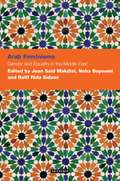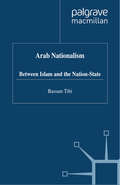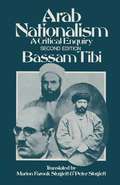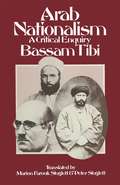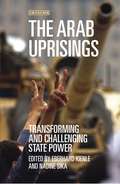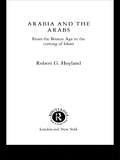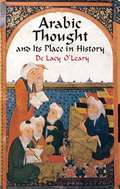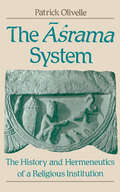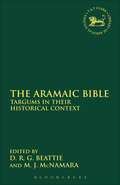- Table View
- List View
Arab Feminisms: Gender And Equality In The Middle East (Contemporary Arab Scholarship in the Social Sciences)
by Rafif Rida Sidawi Noha Bayoumi Jean MakdisiIs there a truly Arab feminist movement? Is there such a thing as 'Islamic' feminism? What does it mean to be a 'feminist' in the Arab world today? Does it mean grappling with the more theoretical elements of the movement? Or does it mean an involvement at the grassroots level with everyday activism? This book examines the issues and controversies that are hotly-debated and contested when it comes to the concept of feminism and gender in Arab society today. It offers explorations of both the theoretical issues at play, the latest developments in feminist discourse, literary studies and sociology, as well as empirical data concerning the situation of women in Arab countries, such as Iraq and Palestine. Arab Feminisms therefore offers valuable theoretical analysis as well as indispensable first-hand accounts of feminism in the Arab world for those researching gender relations in the Middle East and beyond.
The Arab Imago: A Social History of Portrait Photography, 1860–1910
by Stephen SheehiThe first history of indigenous photography in the Middle EastThe birth of photography coincided with the expansion of European imperialism in the Middle East, and some of the medium's earliest images are Orientalist pictures taken by Europeans in such places as Cairo and Jerusalem—photographs that have long shaped and distorted the Western visual imagination of the region. But the Middle East had many of its own photographers, collectors, and patrons. In this book, Stephen Sheehi presents a groundbreaking new account of early photography in the Arab world.The Arab Imago concentrates primarily on studio portraits by Arab and Armenian photographers in the late Ottoman Empire. Examining previously known studios such as Abdullah Frères, Pascal Sébah, Garabed Krikorian, and Khalil Raad, the book also provides the first account of other pioneers such as Georges and Louis Saboungi, the Kova Brothers, Muhammad Sadiq Bey, and Ibrahim Rif'at Pasha—as well as the first detailed look at early photographs of the annual pilgrimage to Mecca. In addition, the book explores indigenous photography manuals and albums, newspapers, scientific journals, and fiction.Featuring extensive previously unpublished images, The Arab Imago shows how native photography played an essential role in the creation of modern Arab societies in Egypt, Palestine, Syria, and Lebanon before the First World War. At the same time, the book overturns Eurocentric and Orientalist understandings of indigenous photography and challenges previous histories of the medium.
Arab liberal thought in the modern age (G - Reference,information And Interdisciplinary Subjects Ser.)
by Meir HatinaThe book provides in-depth analysis of Arab liberalism, which, although lacking public appeal and a compelling political underpinning, still sustained viability over time and remained a constant part of the Arab landscape. The study focuses on the second half of the twentieth century and the early twenty-first century, a period that witnessed continuity as well as change in liberal thinking. Post-1967 liberals, as their predecessors, confronted old dilemmas, socio-economic upheavals, political instability and cultural disorientation, but also demonstrated ideological rejuvenation and provided liberal thought with new emphases and visions. Arab liberals’ ongoing debates over freedom of religion, secularism, individualism, democracy and human rights were aimed at formulating of a comprehensive liberal project seeking to enact an Arab Enlightenment.
Arab liberal thought in the modern age (Manchester University Press)
by Meir HatinaCombining a historical perspective that traces lines of continuity and change in Arab liberalism, an integrative discussion of cross-sectional themes, and a comparative analysis of the West, Turkey and Iran, this book seeks to enrich our knowledge of liberal thought in the Arab Middle East. In intertwining these dimensions—the historic, integrative and comparative, Arab liberal thought in the modern age responds to a tendency to overlook the significance of Middle Eastern liberalism in favour of more powerful and assertive forces embodied by authoritarian regimes and Islamic movements. The study focuses on the second half of the twentieth century and the early twenty-first century. Post-1967 liberals, as their predecessors, confronted old dilemmas, socio-economic upheavals, political instability and cultural disorientation, but also demonstrated ideological rejuvenation and provided liberal thought with new emphases and visions. Arab liberals’ ongoing debates over freedom of religion, secularism, individualism, democracy and human rights were aimed at formulating of a comprehensive liberal project seeking to enact an Arab Enlightenment.
Arab Nationalism: Between Islam and the Nation-State
by B. TibiThe third edition includes a new Part Five on the tensions between Arab nationalism and Islam arising from the crisis of the nation-state and of the de-legitimisation of Pan-Arab regimes. The effects of the Arab defeat in the Six-Day War 1967 and the rise of political Islam in the 1970s are the focus of the new part. The background of the analysis of the impact and function of nationalism and its contribution to social and political change in the Third World, taking the rise of nationalism in the Middle East as a historical example. Professor Tibi concentrates on the period after the First World War, when many Arab intellectuals became disillusioned with Britain and France as a result of the occupation of their countries. One focus of this study are the writings and influence of Sati' al-Husri on Middle Eastern politics. Professor Tibi illustrates the connection between modern Arab nationalism and nineteenth-century German Romantic nationalism, which will be of particular interest to the English reader. Professor Tibi concludes that while nationalism has played a necessary and important role in the movement for national independence in the Middle East, it has since developed into an ideology which seems to obstruct further social and political emancipation. This third edition, brought completely up to date by a substantial new introduction and two new concluding chapters, will be of particular interest to historians and social scientists dealing with nationalism and crises of the nation-state as well as to students of the Middle East and contemporary Islam.
Arab Nationalism: A Critical Enquiry
by B. Tibi ed trans Marion Farouk-Sluglett Peter SluglettIn this new edition Professor Tibi analyses the impact and function of nationalism and its contribution to social and political change in the Third World, taking the rise of nationalism in the Middle East as a historical example. He concentrates on the period after the First World War, when many Arab intellectuals became disillusioned with Britain and France as a result of the occupation of their countries. Professor Tibi's careful study of the writings and influence of Sati' al-Husri illustrates the connection between modern Arab nationalism and nineteenth century German Romantic nationalism, which will be of particular interest to the English reader. Professor Tibi concludes that while nationalism has played a necessary and important role in the movement for national independence in the Middle East, it has since developed into an ideology which seems to obstruct further social and political emancipation. This book will be of particular interest to historians and social scientists as well as to specialists in the area itself.
Arab Nationalism (pdf): A Critical Enquiry
by Bassam Tibi Peter Sluglett Matt DeLisi Ed trans Marion Farouk-SluglettThe Arab Spring and Arab Thaw: Unfinished Revolutions and the Quest for Democracy
by John DavisWhat were the unifying principles or strategies that governed the protest movements that swept the Middle East and North Africa in the spring of 2011? Who were the protestors and how did the different authoritarian regimes respond to them? How did regional and international institutions react to a region in turmoil? The Arab Spring and Arab Thaw; Unfinished Revolutions and the Quest for Democracy addresses these questions by examining a range of successful and unsuccessful protest strategies and counter revolutionary tactics employed by protestors and autocratic regimes. Contributors explore the reactions of the USA, EU and Arab League to events in the region and provide insight as to the gendered dimensions of the struggle along with the ethnic and tribal divisions that continue to impact the post-revolt period. By addressing these critical queries the book demonstrate how the Arab Spring has evolved into a protracted Arab Thaw that continues to profoundly affect regional and international politics.
The Arab Spring and Arab Thaw: Unfinished Revolutions and the Quest for Democracy
by John DavisWhat were the unifying principles or strategies that governed the protest movements that swept the Middle East and North Africa in the spring of 2011? Who were the protestors and how did the different authoritarian regimes respond to them? How did regional and international institutions react to a region in turmoil? The Arab Spring and Arab Thaw; Unfinished Revolutions and the Quest for Democracy addresses these questions by examining a range of successful and unsuccessful protest strategies and counter revolutionary tactics employed by protestors and autocratic regimes. Contributors explore the reactions of the USA, EU and Arab League to events in the region and provide insight as to the gendered dimensions of the struggle along with the ethnic and tribal divisions that continue to impact the post-revolt period. By addressing these critical queries the book demonstrate how the Arab Spring has evolved into a protracted Arab Thaw that continues to profoundly affect regional and international politics.
The Arab Uprisings: Transforming and Challenging State Power (Library of Modern Middle East Studies)
by Nadine Sika Eberhard KienleThe uprisings which spread across the Middle East and North Africa in late 2010 and 2011 irrevocably altered the way in which the region is now perceived. But in spite of the numerous similarities in these protests, from Tunisia and Egypt to Yemen and Bahrain, their broader political effects display important differences. This book analyses these popular uprisings, as well as other forms of protest, and the impact they had on each state. Why were Mubarak and Bin Ali ousted relatively peacefully in Egypt and Tunisia, while Qadafi in Libya and Saleh in Yemen fought violent battles against their opponents? Why do political transformations differ in countries that were able to shed their autocratic presidents? And why have other regimes, including Morocco and Saudi Arabia, experienced only limited protests or managed to repress and circumvent them? Looking at the aftermath and transitional processes across the region, this book is a vital retrospective examination of the uprisings and how they can be understood in the light of state formation and governmental dynamics.
The Arab Winter: A Tragedy
by Noah FeldmanWhy the conventional wisdom about the Arab Spring is wrongThe Arab Spring promised to end dictatorship and bring self-government to people across the Middle East. Yet everywhere except Tunisia it led to either renewed dictatorship, civil war, extremist terror, or all three. In The Arab Winter, Noah Feldman argues that the Arab Spring was nevertheless not an unmitigated failure, much less an inevitable one. Rather, it was a noble, tragic series of events in which, for the first time in recent Middle Eastern history, Arabic-speaking peoples took free, collective political action as they sought to achieve self-determination.Focusing on the Egyptian revolution and counterrevolution, the Syrian civil war, the rise and fall of ISIS in Syria and Iraq, and the Tunisian struggle toward Islamic constitutionalism, Feldman provides an original account of the political consequences of the Arab Spring, including the reaffirmation of pan-Arab identity, the devastation of Arab nationalisms, and the death of political Islam with the collapse of ISIS. He also challenges commentators who say that the Arab Spring was never truly transformative, that Arab popular self-determination was a mirage, and even that Arabs or Muslims are less capable of democracy than other peoples.Above all, The Arab Winter shows that we must not let the tragic outcome of the Arab Spring disguise its inherent human worth. People whose political lives had been determined from the outside tried, and for a time succeeded, in making politics for themselves. That this did not result in constitutional democracy or a better life for most of those affected doesn't mean the effort didn't matter. To the contrary, it matters for history—and it matters for the future.
The Arab World and Iran: A Turbulent Region in Transition (Middle East Today)
by Amin SaikalThis volume focuses on interpreting the changing domestic and regional dynamics in the Arab world and Iran. Its chapters discuss an array of countries, events, actors, and issues - from an examination of the Arab Spring and the Tunisian democratic transition, to an exploration of the role of Saudi-Iranian geostrategic rivalry, to the impact of ethnic and sectarian politics in Syria, Iraq, and across the region. Chapters from expert contributors are organized into three parts. The first section of the volume covers the aspects and dynamics of change in the Arab world. The second examines the role of Islam, Islamism, Islamic governance, and sectarian and ethnic politics in the region. The third section focuses on Iranian domestic and regional politics. Yet the theme of transition is constant throughout as this multidisciplinary book draws connections across countries and events to not only inform about the prevailing regional situation, but also to invite readers to draw their own conclusions as to the future of the Middle East. Collectively the volume provides a fresh interpretation of the changing dynamics of the Arab world and Iran, unpacking the complexities of the disputes, conflicts, rivalries, failed goals, and processes of change and development that have made the Muslim Middle East so turbulent, directionless, and perpetually contested by both regional and international actors.
Arabia and the Arabs: From the Bronze Age to the Coming of Islam
by Robert G. HoylandLong before Muhammed preached the religion of Islam, the inhabitants of his native Arabia had played an important role in world history as both merchants and warriorsArabia and the Arabs provides the only up-to-date, one-volume survey of the region and its peoples, from prehistory to the coming of IslamUsing a wide range of sources - inscriptions, poetry, histories, and archaeological evidence - Robert Hoyland explores the main cultural areas of Arabia, from ancient Sheba in the south, to the deserts and oases of the north. He then examines the major themes of*the economy*society*religion*art, architecture and artefacts*language and literature*Arabhood and ArabisationThe volume is illustrated with more than 50 photographs, drawings and maps.
Arabia and the Arabs: From the Bronze Age to the Coming of Islam
by Robert G. HoylandLong before Muhammed preached the religion of Islam, the inhabitants of his native Arabia had played an important role in world history as both merchants and warriorsArabia and the Arabs provides the only up-to-date, one-volume survey of the region and its peoples, from prehistory to the coming of IslamUsing a wide range of sources - inscriptions, poetry, histories, and archaeological evidence - Robert Hoyland explores the main cultural areas of Arabia, from ancient Sheba in the south, to the deserts and oases of the north. He then examines the major themes of*the economy*society*religion*art, architecture and artefacts*language and literature*Arabhood and ArabisationThe volume is illustrated with more than 50 photographs, drawings and maps.
The Arabic Freud: Psychoanalysis and Islam in Modern Egypt
by Omnia El ShakryThe first in-depth look at how postwar thinkers in Egypt mapped the intersections between Islamic discourses and psychoanalytic thoughtIn 1945, psychologist Yusuf Murad introduced an Arabic term borrowed from the medieval Sufi philosopher and mystic Ibn ‘Arabi—al-la-shu‘ur—as a translation for Sigmund Freud’s concept of the unconscious. By the late 1950s, Freud’s Interpretation of Dreams had been translated into Arabic for an eager Egyptian public. In The Arabic Freud, Omnia El Shakry challenges the notion of a strict divide between psychoanalysis and Islam by tracing how postwar thinkers in Egypt blended psychoanalytic theories with concepts from classical Islamic thought in a creative encounter of ethical engagement.Drawing on scholarly writings as well as popular literature on self-healing, El Shakry provides the first in-depth examination of psychoanalysis in Egypt and reveals how a new science of psychology—or “science of the soul,” as it came to be called—was inextricably linked to Islam and mysticism. She explores how Freudian ideas of the unconscious were crucial to the formation of modern discourses of subjectivity in areas as diverse as psychology, Islamic philosophy, and the law. Founding figures of Egyptian psychoanalysis, she shows, debated the temporality of the psyche, mystical states, the sexual drive, and the Oedipus complex, while offering startling insights into the nature of psychic life, ethics, and eros.This provocative and insightful book invites us to rethink the relationship between psychoanalysis and religion in the modern era. Mapping the points of intersection between Islamic discourses and psychoanalytic thought, it illustrates how the Arabic Freud, like psychoanalysis itself, was elaborated across the space of human difference.
The Arabic Freud: Psychoanalysis and Islam in Modern Egypt
by Omnia El ShakryThe first in-depth look at how postwar thinkers in Egypt mapped the intersections between Islamic discourses and psychoanalytic thoughtIn 1945, psychologist Yusuf Murad introduced an Arabic term borrowed from the medieval Sufi philosopher and mystic Ibn ‘Arabi—al-la-shu‘ur—as a translation for Sigmund Freud’s concept of the unconscious. By the late 1950s, Freud’s Interpretation of Dreams had been translated into Arabic for an eager Egyptian public. In The Arabic Freud, Omnia El Shakry challenges the notion of a strict divide between psychoanalysis and Islam by tracing how postwar thinkers in Egypt blended psychoanalytic theories with concepts from classical Islamic thought in a creative encounter of ethical engagement.Drawing on scholarly writings as well as popular literature on self-healing, El Shakry provides the first in-depth examination of psychoanalysis in Egypt and reveals how a new science of psychology—or “science of the soul,” as it came to be called—was inextricably linked to Islam and mysticism. She explores how Freudian ideas of the unconscious were crucial to the formation of modern discourses of subjectivity in areas as diverse as psychology, Islamic philosophy, and the law. Founding figures of Egyptian psychoanalysis, she shows, debated the temporality of the psyche, mystical states, the sexual drive, and the Oedipus complex, while offering startling insights into the nature of psychic life, ethics, and eros.This provocative and insightful book invites us to rethink the relationship between psychoanalysis and religion in the modern era. Mapping the points of intersection between Islamic discourses and psychoanalytic thought, it illustrates how the Arabic Freud, like psychoanalysis itself, was elaborated across the space of human difference.
The Arabic Historical Tradition & the Early Islamic Conquests: Folklore, Tribal Lore, Holy War
by Boaz ShoshanThe early Arab conquests pose a considerable challenge to modern-day historians. The earliest historical written tradition emerges only after the second half of the eighth century- over one hundred years removed from the events it contends to describe, and was undoubtedly influenced by the motives and interpretations of its authors. Indeed, when speaking or writing about the past, fact was not the only, nor even the prime, concern of Muslims of old. The Arabic Historic Tradition and the Early Islamic Conquests presents a thorough examination of Arabic narratives on the early Islamic conquests. It uncovers the influence of contemporary ideology, examining recurring fictive motifs and evaluating the reasons behind their use. Folklore and tribal traditions are evident throughout the narratives, which aimed to promote individual, tribal and regional fame through describing military prowess in the battles for the spread of Islam. Common tropes are encountered across the materials, which all serve a central theme; the moral superiority of the Muslims, which destined them to victory in God’s plan. Offering a key to the state of mind and agenda of early Muslim writers, this critical reading of Arabic texts would be of great interest to students and scholars of early Arabic History and Literature, as well as a general resource for Middle Eastern History.
The Arabic Historical Tradition & the Early Islamic Conquests: Folklore, Tribal Lore, Holy War
by Boaz ShoshanThe early Arab conquests pose a considerable challenge to modern-day historians. The earliest historical written tradition emerges only after the second half of the eighth century- over one hundred years removed from the events it contends to describe, and was undoubtedly influenced by the motives and interpretations of its authors. Indeed, when speaking or writing about the past, fact was not the only, nor even the prime, concern of Muslims of old. The Arabic Historic Tradition and the Early Islamic Conquests presents a thorough examination of Arabic narratives on the early Islamic conquests. It uncovers the influence of contemporary ideology, examining recurring fictive motifs and evaluating the reasons behind their use. Folklore and tribal traditions are evident throughout the narratives, which aimed to promote individual, tribal and regional fame through describing military prowess in the battles for the spread of Islam. Common tropes are encountered across the materials, which all serve a central theme; the moral superiority of the Muslims, which destined them to victory in God’s plan. Offering a key to the state of mind and agenda of early Muslim writers, this critical reading of Arabic texts would be of great interest to students and scholars of early Arabic History and Literature, as well as a general resource for Middle Eastern History.
Arabic in the Fray: Language Ideology and Cultural Politics
by Yasir SuleimanThe pre-modern period saw a background of inter-ethnic strife among Arabs and non-Arabs, mainly Persians. Starting from the symbolic and cognitive roles of language, Yasir Suleiman shows how discussions about the inimitability and (un)translatability of the Qur’an in this period were, at some deep level, concerned with issues of ethnic election. In this respect, theology and ethnicity emerge as partners in theorising language. Staying within the symbolic role of language, Suleiman goes on to investigate the role of paratexts and literary production in disseminating language ideologies and in cultural contestation. He shows how language symbolism is relevant to ideological debates about hybrid and cross-national literary production in the Arab milieu. In fact, language ideology appears to be everywhere, and a whole chapter is devoted to discussions of the cognitive role of language in linking thought to reality.
The Arabic Influences on Early Modern Occult Philosophy (Palgrave Historical Studies in Witchcraft and Magic)
by Liana SaifInvestigating the impact of Arabic medieval astrological and magical theories on early modern occult philosophy, this book argues that they provided a naturalistic explanation of astral influences and magical efficacy based on Aristotelian notions of causality.
Arabic Thought and Its Place in History
by De Lacy O'LearyWell-documented study of the mutual influence of Arabic and Western worlds during the Middle Ages traces the transmission of Greek philosophy and science to the Islamic cultures. A fascinating portrait of medieval Muslim thought, it illustrates commonalities with Judaic and Christian teachings as well as points of divergence.
The =Aśrama System: The History and Hermeneutics of a Religious Institution
by Patrick OlivelleThe lesser known and explored of the two pillars of Hinduism--=aśrama and var.na--=aśrama is the name given to a system of four distinct and legitimate ways of leading a religious life: as a celibate student, a married householder, a forest hermit, and a world renouncer. In this, the first full-length study of the =aśrama system, Olivelle uncovers its origin and traces its subsequent history. He examines in depth its relationship to other institutional and doctrinal aspects of the Brahmanical world and its position within Brahmanical theology, and assesses its significance within the history of Indian religion. Throughout, he argues that the =aśrama system is primarily a theological construct and that the system and its history should be carefully distinguished from the socio-religious institutions comprehended by the system and from their respective histories.
The Aramaic and Egyptian Legal Traditions at Elephantine: An Egyptological Approach (The Library of Second Temple Studies #64)
by Alejandro F. BottaThis is a study of the interrelationships between the formulary traditions of the legal documents of the Jewish colony of Elephantine and the legal formulary traditions of their Egyptian counterparts. The legal documents of Elephantine have been approached in three different ways thus far: first, comparing them to the later Aramaic legal tradition; second, as part of a self-contained system, and more recently from the point of view of the Assyriological legal tradition. However, there is still a fourth possible approach, which has long been neglected by scholars in this field, and that is to study the Elephantine legal documents from an Egyptological perspective. In seeking the Egyptian parallels and antecedents to the Aramaic formulary, Botta hopes to balance the current scholarly perspective, based mostly upon Aramaic and Assyriological comparative studies.
The Aramaic Bible: Targums in their Historical Context (The Library of Hebrew Bible/Old Testament Studies)
by Derek R. Beattie Martin J. McNamaraThe twenty-six essays in this volume represent the papers read at the international Conference on the Aramiac Bible held in Dublin (1992). The purpose of the Conference was to bring together leading specialists on the Targums and related topics to discuss issues in the light of recent developments, for instance Second Temple interpretation of the Scriptures, Qumran Literature, targumic and Palestinian Aramaic, new Genizah manuscripts, Jewish tradition, Origen's Hexapla, Pseudepigrapha, Apocrypha and the Christian West. The papers are arranged under seven headings: Targum Texts and Editions; The Aramaic Language: The Targums and Jewish Biblical Interpretation; Targums of the Pentateuch; Targums of the Hagiographa; Targums and New Testament; Jewish Traditions and Christian Writings. The international team, drawn from nine countries, is as follows (following the order of the papers); M. Klein, S. Reif, L. Diez Merino, R. Gordon, M. McNamara, S.A. Kaufman, E. Cook, M. Hengel, O. Betz, A. Shinan, J. Ribera, B. Grossfeld, P.V.M. Flesher, G. Boccaccini, M. Maher, R. Hayward, R. Syren, P.S. Alexander, D.R.G. Beattie, C. Mangan, B. Ego, M. Wilcox, B. Chilton, G.J. Norton, B. Kedar Kopstein, M. Stone.
Aramaic Daniel and Greek Daniel: A Literary Comparison (The Library of Hebrew Bible/Old Testament Studies)
by T. J. MeadowcroftDaniel 2-7 are noteworthy chapters in the Bible, partly because they are in Aramaic rather than Hebrew and partly because the early Greek translation of those chapters, known to us as the Septuagint, is quite different from the Aramaic text that we have. This book highlights and analyzes the differences by exploring the effectiveness of each version as a piece of narrative. A new appreciation of the craft of the Aramaic narrative is one result. Another is an enhanced understanding of how biblical narrative handles symbolism. Through this study the reader also gains insight into differing circles of wisdom in Persian times, each giving rise to a textual tradition still accessible to us.
